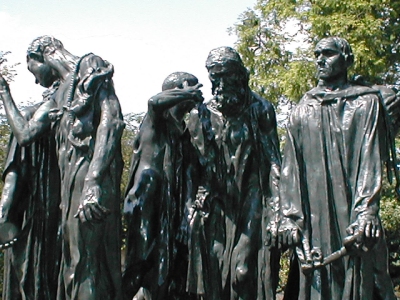No False Medicine--Amardeep Singh 

Monday, May 24, 2004
Burghers of Calais; Understanding the Brazilian pop music fad

I took a snap of this sculpture in a trip to the Washington Mall over the weekend. It's "The Burghers of Calais" by the French sculptor August Rodin, and it sits at the Hirshorn Sculpture Gallery. (Rodin's famous sculpture, "Monument to Balzac" also sits there, but I've never quite been able to understand why it's so famous.)
The story is of the town of Calais. After a year of siege by England (1346-7), the King of France abandoned the town. The King of England could therefore dictate his own terms for the surrender of the city. He demanded the wealthiest and most respectable citizens of the town to come to the gates, barefoot and shackled, for the king to do with as he pleased.
So the sculpture is about sacrifice. The faces of the subjects express the despair of those who had thought themselves to be invulnerable, and who face imminent doom. Part of why it became famous is Rodin's choice to focus on the heroism and sacrifice of ordinary people. In the late 19th century it was still quite rare to make this choice -- public monuments were generally of generals, kings, or religious martyrs.
Brazilian dance music: Samba, Batucada
In the car on the way home, I had an epiphany while listening to Zuco 103's Tales of High Fever.
About three or four years ago there was the start of a global craze for Brazilian dance music, motivated in my mind by three overlapping interests. First, there is a growing desire amongst European and American club-goers for dance music based on live percussion elements as a 'warm' counter to the cold aesthetics of purely electronic dance music. (The heavy, human percussion of Brazilian music is an analogue to the dhol of Bhangra; both are popular; they can even be blended together). Secondly, the Brazil music fad has piggybacked on another Brazil fad -- the explosion of interest in the martial art form known as capoeira. The third thing to mention is that the vast majority of listeners, myself included, don't know any Portuguese, which means that reaction to the vocals is primarily driven to the sound of the voice, rather than meaning. Granted, the interest in the sound of the voice has been a big part of the popularity of Punjabi Bhangra as well as the Algerian popular music called Rai (which will have to be the subject of another post), but it is, on the whole, a little fishy. The lack of knowledge also makes fads somewhat hard to sustain. If you don't know the lyrics and don't have ways of learning, you don't develop deeper associations with what you're hearing. Fads developed on such a basis are not likely to last long.
The above is the social (or sociological) confusion behind the Brazil fad. But the Brazil music fad is also confusing musically, for a different set of reasons. No distinctions have been made between electrified samba, with house music beats (Ian Pooley), on the one hand, and the Afro-Brazilian percussion music called batucada (batuque), which originated in the slums of the Bahia (the northern part of Brazil). For most listeners (including myself on occasion), it's all lumped into the large generic khichdi called 'Brazil'.
According to The Rough Guide ot World Music, the genealogy of Brazilian popular music is a complex tree, with nearly as many branches as there are in American pop music. To begin with, there are actually two kinds of samba, the samba de enredo, which is loud, percussion-based music produced mainly for carnaval, and samba cancao (song samba), which is samba with guitar, slowed down and intended for everyday listening. It's the latter that, merged with American jazz, led to bossa nova, which became Brazil's trademark sound after the early 1960s (Stan Getz, Jao Gilberto, Astrud Gilberto: an earlier fad).
The latest fad for Brazilian music has really been for its dance music -- carnaval samba and batucada -- not so much bossa nova or its offshoots (i.e., tropicalia). There are many compilations for this type of music, samba especially, but probably the best are the German Glucklich compilations, which are selected by the German DJ Rainer Truby. (I would also recommend Ian Pooley and Spiller.) It's primarily the electronic samba side of Brazilian music that produced the group called Zuco 103. I heard their first CD, Outro Lado, about four years ago, when I was a DJ and a music reviewer at a college radio station called WXDU. It was a startling CD, clearly a hybrid, but in a sense that sounded new.
Still, even in the midst of hybrid glut, I felt there was something missing from the Outro Lado CD -- the songs seemed unfinished, the melodies too simple. It was as if the band was intoxicated by the idea of hybridity and eclecticism, but unable or uninterested in developing a new aural coherence. And when Tales of High Fever came out, I was again disappointed at first. Most tracks weren't aggressive enough to be playable at a dance party, and yet it wasn't smooth or romantic enough to compare with the pretty songs of, for instance, Caetano Veloso. So I rarely listened to it.
Yesterday, stuck in traffic and having exhausted all of the CDs in the CD wallet, I finally put it on again, and was enthralled. There is coherence here, though it swings between between samba, jazz, house music, and pop. And Lilian Vieira manages to do all kinds of interesting (sometimes shocking) things with her voice. I won't attempt a full review, just go here. Six Degrees is also helpful in providing lyrics which means even a non-Portuguese speaker like me has a shot at learning & memorizing the lyrics, thereby making my interest more than just a fad... well, possibly.
